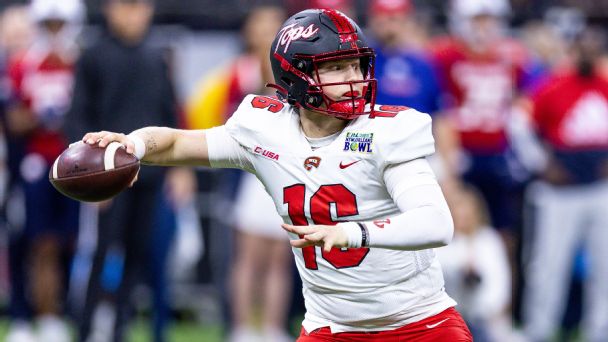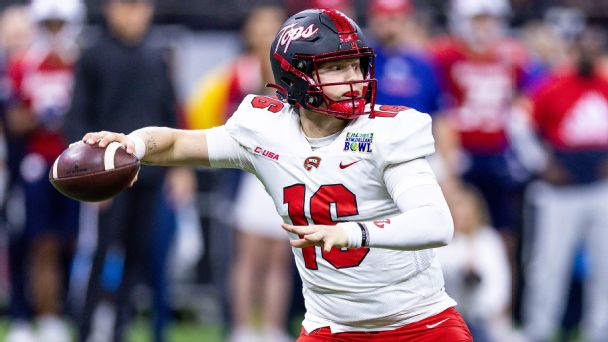
In 27 seasons, Conference USA has produced 29 champions or co-champions. The conference’s nine current members have accounted for … two of them. Western Kentucky won in 2015 and 2016. That’s the entire list.
C-USA is college football’s ultimate way station, a stopping point on your way up or down the football ladder, but temporary home or no, this is typically a conference full of variety and loads of tight games. There’s nothing wrong with that, and there’s no reason to think 2023 will be anything different.
SP+ projects four teams within 0.8 conference wins of each other atop the league, and the variety of approaches is pretty clear. WKU’s Tyson Helton made his team a league favorite by deciding to air out the football. Louisiana Tech coach Sonny Cumbie doesn’t mind going vertical, Middle Tennessee‘s Rick Stockstill has saved his job multiple times with a relentless horizontal passing game and UTEP‘s Dana Dimel just wants to push you over. Florida International‘s Mike MacIntyre? His approach has shifted at times, but he’s won 10 games at both Colorado and San Jose State — he’s fearless and willing to try just about anything.
Last week, we previewed C-USA’s four newcomers; this time around, let’s look at the holdovers.
Every week through the offseason, Bill Connelly will preview another division from the Group of 5 and Power 5 exclusively for ESPN+, ultimately including all 133 FBS teams. The previews will include 2022 breakdowns, 2023 previews and burning questions for each team.
Earlier previews: Conference USA (newcomers)
2022 recap
Here are last year’s Conference USA standings. Returning teams are in bold.
UTSA: 8-0 in conference (plus C-USA championship game win), 11-3 overall
North Texas: 6-3 (plus C-USA championship game loss), 7-7
Western Kentucky: 6-2, 9-5
Middle Tennessee: 4-4, 8-5
UAB: 4-4, 7-6
Florida Atlantic: 4-4, 5-7
Rice: 3-5, 5-8
UTEP: 3-5, 5-7
Florida International: 2-6, 4-8
Charlotte: 2-6, 3-9
Louisiana Tech: 2-6, 3-9
WKU was fun, explosive and just about the most pass-happy team in FBS but stunk in the red zone, couldn’t create enough disruption and allowed 36 points per game in five losses. MTSU rode a nonstop roller coaster — it got blown out by James Madison, won three in a row (including a 45-31 humbling of Miami), lost three in a row, then won five of six — while UTEP’s ride, which included a stretch of four wins in six games and an upset of Boise State, needed one more upswing and fell short of the postseason.
Down at the bottom, Florida International winning four games in MacIntyre’s first season was a pleasant surprise, while Louisiana Tech winning three in Cumbie’s first season was less pleasant. (That the Air Raid protégé produced a team capable of making lots of big plays and allowing even more, however, wasn’t much of a bombshell.)
2023 projections
Among the five returning teams, the projected order of finish is the same as last year, with one exception. The combination of strong returning production numbers and Cumbie’s aggressive use of the transfer portal (16 transfers and counting, six from power conferences) gives Louisiana Tech some turnaround potential. The next time the Bulldogs look good on defense, however, will be the first time since about 2019.
Burning questions
Can Western Kentucky make at least a few stops this year? Credit Helton for realizing that something needed changing, then changing it. After inheriting a 3-9 program from Mike Sanford in 2019, Helton went 14-11 over his first two seasons in charge but did so with offenses that ranked 116th and 120th, respectively, in offensive SP+. The defense was one of the best in the Group of 5, but (a) defense alone doesn’t sell a ton of tickets, and (b) it evidently doesn’t win enough games by itself either.
Helton pulled off one of the first big swings of the transfer portal era in 2021, bringing in Houston Christian offensive coordinator Zach Kittley and a number of HCU players, including quarterback Bailey Zappe, and it worked wonders. WKU jumped to 9-5 in 2021, surged to sixth in offensive SP+ and reached the C-USA championship game for the first time in five years. Kittley left for Texas Tech, Zappe left for the New England Patriots, but the Hilltoppers held on to rank 45th in offensive SP+ and win another nine games last fall.
Now, with their bogey team gone — the Hilltoppers were 0-3 against AAC-bound UTSA but 13-1 against everyone else in the C-USA in 2021 and ’22 — they assume the role of conference favorite alongside newcomer Liberty. The nonconference slate includes road trips to Ohio State and Troy (one of my favorite nonconference games on the schedule, honestly), but they’re at least slight favorites in each of their other 10 games.
The projections are pretty optimistic despite a defense that has struggled for traction since Helton took on the high-octane offense. WKU was 81st in defensive SP+ last season, and now second-year coordinator Tyson Summers must replace five of last year’s top six linemen, three of the top four linebackers and his two most active defensive backs.
Unafraid of looking for help in the transfer portal, Helton is bringing in six defensive transfers so far, including sophomore tackles Dallas Walker IV (Texas A&M) and Marquis Black (Nebraska), but outside of dynamite edge rusher JaQues Evans (12 TFLs, 9 sacks, 13 run stops in 2022), there aren’t many proven entities here.
WKU will score points, however. Lots of them. Former Division II national champion Austin Reed took over as quarterback last season and threw for 4,744 yards and 40 touchdowns, and after considering a transfer he elected to return with help from WKU’s NIL collective.
We could not be more excited to start our partnership with one of the nations leading passers @Areed365
Austin will be partnering on some real estate content and helping us spread the word about non profit work with @redtoweltrust
Please donate at https://t.co/8hzgaVVtZh pic.twitter.com/O07pXQytFx
— Hank Wilson (@HanksHomesBG) December 14, 2022
With prolific slot man Malachi Corley back as well, in addition to some exciting portal additions — Tennessee’s Jimmy Holiday, Cincinnati’s Blue Smith, Auburn’s Ze’Vian Capers — Reed should threaten 5,000 yards if healthy, and WKU will again be one of the most exciting teams in the G5 universe. Becoming one of the best G5 teams, however, will require making a few stops on defense and winning a few more red zone trips. As explosive as they were, they ranked just 84th in red zone touchdown rate on offense (58.3%) and 67th on defense (60.0%).
Red zone failures have contributed to just a 2-7 record in one-score games over the last two seasons, which potentially cost them a pair of conference titles. Helton has made WKU both good and loads of fun, but there are even more wins available if the Hilltoppers can take care of a few more little things. And make a few more stops.
Who is more likely to become Contender No. 3, Middle Tennessee or Louisiana Tech? Middle Tennessee’s Stockstill gave us maybe the best postgame press conference of 2022. After his team put up 507 yards and 45 points in a two-touchdown win over Miami, Stockstill was, to say the least, a little fired up.
SAY IT LOUDER @CoachStock 🗣#BLUEnited | #EATT pic.twitter.com/HK36kIjC8b
— Middle Tennessee FB (@MT_FB) September 25, 2022
“Coming down here, 26-point dogs and kickin’ their butt like we did — because it was a butt kickin’, it was no fluke to this. We were the tougher team here tonight.” He later threw in a “Knocked those suckers off” and a “They gave $1.5 million, we gave them 1.6 yards per carry” for good measure. An A+ performance on the mic after an A+ performance on the sideline.
The 65-year old Stockstill is just 109-103 in 17 seasons in Murfreesboro, but he’s scored a number of big-time wins (six over power conference teams), he’s been conference Coach of the Year three times, he’s taken the Blue Raiders to 10 bowls, he got to coach his son Brent (12,483 passing yards from 2014 to ’18), and in September he signed a contract extension to keep him in town through 2028. A pretty good life, if we’re being honest!
The MTSU defense was the stronger unit last year and should be again, returning 12 of the 15 players who saw at least 300 snaps. They must replace their best overall player (defensive end Jordan Ferguson), but Zaylin Wood and Marley Cook are big play-makers up front, and corner Teldrick Ross is nasty.
The trick comes on the other side of the ball, where Stockstill must replace 3,000-yard passer Chase Cunningham and his three leading receivers. Running back Frank Peasant could be a star with better blocking – he averaged an awesome 3.3 yards per carry after contact on his way to … just 4.3 yards per carry overall – and both Nicholas Vattiato and Presbyterian transfer Ren Hefley have starting experience at quarterback. But receivers DJ England-Chisolm and Elijah Metcalf will need to come up big for MTSU to make a title charge. The Blue Raiders start the season at Alabama and at Missouri, then visit WKU and Liberty in conference play. They’re projected favorites in each of their other eight games, however, and they’re perhaps only one road upset from getting involved in the conference title race.
After what we saw last year, MTSU is probably a more trustworthy team than Louisiana Tech. But we caught glimpses of what a high-flying Cumbie program might look like. Tech scored 34 points or more five times amid a ton of growing pains.
Cumbie, the former Texas Tech and TCU offensive coordinator, is hoping some ringers help him out in 2023. He brought in high-profile transfers Boise State quarterback Hank Bachmeier, Baylor running back Sqwirl Williams and Nebraska receiver Decoldest Crawford (of air conditioner fame), plus a freshman class loaded with three-star prospects. Receivers Smoke Harris and Cyrus Allen are strong building blocks, and the defensive front six is loaded with experience (if not proven success).
A former four-star recruit, Bachmeier battled injury and inconsistency over parts of four seasons in Boise and only once landed in the Total QBR top 50. But he’s joining a QB-friendly coach and inheriting a solid supporting cast. It wouldn’t be a surprise if Tech finished in the offensive SP+ top 60 for a fourth straight year. Of course, they’ve gone just 11-23 over the last three years because they’ve averaged a defensive SP+ ranking of 118th. Tackle Keivie Rose is a big play-maker up front, and cornerback Willie Roberts is a keeper — Stephen F. Austin transfers have been good for Cumbie thus far. But coordinator Scott Power, another former SFA Lumberjack, still has lots of work to do.
Has the boulder run over Dana Dimel? For any number of obvious reasons, the UTEP job is a difficult one. El Paso is technically in Texas but without any of the “loads of Texas high school talent nearby” benefits, and despite a pocket of passionate fans in a cool city and a cool stadium, the Miners have bowled just seven times in 55 years and have won more than eight games just twice ever.
That Dimel has gone 12-13 over the last two seasons — after going 5-27 in his first three — is itself an impressive accomplishment. His Miners finished 7-6 and 88th in SP+ in 2021, their best ranking in 13 years, and followed that up with a decent if eventually unsuccessful 5-7 campaign last fall.
This is one of the proverbial “pushing a boulder up a hill” programs, though: The moment your momentum stops, the boulder tends to roll all the way back to the bottom, flattening you along the way. Sean Kugler went 12-13 in 2014-15, then 4-20 from there. Mike Price went 8-4 in both 2004 and 2005, then finished with seven straight losing seasons. Neither of those guys coached in the portal era, either, where a school like UTEP can lose its stars awfully easily. Dimel must rebuild momentum without the help of either 1,000-yard receiver Tyrin Smith (now at Texas A&M) or all-conference tackle Jeremiah Byers (Florida State).
The solution? For Dimel, it’s doubling down on a reliable source of UTEP talent, a source that’s now neglected a bit nationally because of the portal: JUCOs. By my count, Dimel signed 25 junior college transfers in this signing class, most of whom are in for spring practice. Twenty-five! He loaded up at every position besides quarterback, where he already returns veteran Gavin Hardison, and he signed some mid-three-star freshmen, including running back Ezell Jolly, who could be useful sooner than later.
This massive influx of seasoned pieces joins Hardison, veteran running back Deion Hankins, a huge and experienced offensive line led by potential all-conference guards Elijah Klein and Justin Mayers, eight defensive returnees who saw at least 200 snaps last year (including a couple of high-end linemen in end Praise Amaewhule and tackle Keenan Stewart), returning cornerback Torey Richardson (good in 2021, hurt in 2022) and New Mexico cornerback transfer A.J. Odums. Despite the lost star power, it’s not hard to talk yourself into the idea that this roster might be better than last year’s. The Miners are projected to drop in SP+, in part because a lot of the JUCO signees were unrated, but experience levels are high. They’re projected underdogs in 11 of 12 games, but seven of those games are projected within five points. Exceed expectations by just a little bit, and a bowl run is possible. The boulder might not be back at the bottom of the hill just yet.
Can Mike MacIntyre stabilize Florida International? If I told you that FIU was projected 129th in SP+ last year, and then finished 129th, that would feel downright orderly, wouldn’t it? MacIntyre inherited a program that had lost 18 of 19 games — 17 in a row to FBS teams — and managed to take down a few bad teams (Bryant, Charlotte, Louisiana Tech and a pre-turnaround New Mexico State) while getting blown out a ton.
There was really nothing orderly about the Panthers’ season, however. They overachieved projections by at least 12 points four times and underachieved by at least 18.5 points six times. The plan was either surprisingly effective or a disaster from the opening kick.
Credit MacIntyre for taking some high-variance swings, though. FIU was occasionally disruptive with its linebackers and secondary, and MacIntyre and veteran offensive coordinator David Yost were as aggressive as they could realistically be in going for it on fourth down: 34 conversion attempts (12th in FBS) and a 60% go-for-it rate in opponents’ territory (third). It occasionally worked and quite often did not (fourth-down conversion rate: 44%, 97th), but the Panthers were not interested in merely trying to lose by small amounts. They wanted to throw some haymakers.
FIU should improve a bit in 2023 if only because of experience: Of the 31 players who saw at least 250 snaps last year, 22 return, including running back Lexington Joseph, honorable mention all-conference guard Jacob Peace, sophomore defensive tackle Jordan Guerad, linebacker Donovan Manuel, edge rusher Shaun Peterson Jr. and nickel back Jamal Potts. MacIntyre was active in the portal, too, bringing in 11 guys and counting.
The Panthers lose two of the three receivers with 25-plus catches, and they could certainly use improvement from quarterbacks Grayson James and/or Haden Carlson. But while experience can’t make a bad roster good, it can produce improvement. So can MacIntyre. His track record of turnarounds was an obvious draw. He inherited a 2-10 San Jose State team, went 1-12 in his first year, then improved to 5-7 and 11-2 before taking the Colorado job. In Boulder, he took over a team that had won four games in two years, and after going 10-27 in his first three seasons, he went 10-4 in his fourth before returning to five-win land. He doesn’t mind setting examples and taking time, and despite a poor overall product, four wins was more than anyone could have expected last season. Perhaps the Panthers can grow a bit more consistent in year two.
My 10 favorite players
QB Austin Reed, WKU. The West Florida transfer ranked 37th in Total QBR and led the nation in passing yards in his first FBS season. Let’s see what he can do with experience and a high-end receiving corps.
RB Sqwirl Williams, Louisiana Tech. Williams was part of a stable of backs at Baylor, but his brightest moments were awfully bright: 192 rushing yards and two scores at Oklahoma, then 112 against eventual national runner-up TCU. Great nickname, too.
WR Malachi Corley, WKU. The junior from Orange City, Florida, became fast friends with Reed, gaining 90-plus receiving yards in nine of his last 11 games in 2022 on his way to a 1,293-yard, 11-touchdown campaign.
LT Steven Hubbard, UTEP. Really, take your pick from about three Miners linemen. I mentioned Klein and Mayers above, but Hubbard allowed just two sacks and produced an overall 1.0% blown block rate in 2022, about as good as you’ll see from a left tackle.
LG John Bock II, FIU. As a true freshman, the Fort Lauderdale product divided time at center and both guard positions, committed just two penalties all season and produced a 1.2% blown block rate. Ceiling: high.
DT Marley Cook, MTSU. I couldn’t decide between Cook and end Zaylin Wood, so the tie goes to the bigger dude. Cook recorded 6.5 sacks (a huge number for a 306-pounder) and missed only one tackle all season. If he grabs you, you’re down.
Edge Praise Amaewhule, UTEP. You know you’re pretty good when you record seven TFLs and it’s a letdown. After a 17-TFL season in 2021, Amaewhule battled loads of double-teams and still produced at times while opening up sack chances for teammates.
Edge Shaun Peterson Jr., FIU. The efficient Peterson, another Fort Lauderdale product, recorded six sacks and 14 pressures in just 118 pass rush attempts. Imagine what he could do if FIU forced a few more passing downs.
CB Teldrick Ross, MTSU. Only Toledo’s Quinyon Mitchell defensed (intercepted or broke up) more passes than Ross, who finished the season with two picks and 19 breakups. Opposing quarterbacks managed just a 26.8 QBR throwing his way.
Nickel Cecil Singleton Jr., Louisiana Tech. FBS players with at least 6 TFLs, 3 forced fumbles, 1 interception, 5 breakups and 7 run stops in 2022: two. Singleton and UTEP’s Tyrice Knight were the only ones to pull off that combo.
Anniversaries
In 1973, 50 years ago, Louisiana Tech beat Western Kentucky for the Division II title. In front of a crowd of 12,016 in Sacramento, California, Tech’s Wenford Wilborn set up one touchdown with a long punt return and another with an interception, and the Bulldogs dominated, forcing five turnovers, outgaining the Hilltoppers 336-76 and rolling 34-0. The teams have split six meetings since becoming C-USA rivals, but Tech’s got the ring.
In 1988, 35 years ago, UTEP won 10 games for the first (and only) time. Pat Hegarty threw for 2,732 yards — the equivalent of, what, 4,500 today? — as Bob Stull’s Miners won seven games by at least 17 points and finished the regular season 10-2 before losing both the Independence Bowl (to Brett Favre’s Southern Miss) and Stull (to Missouri). They wouldn’t win even six games in a season for another 12 years.
In 1998, 25 years ago, Troy Edwards had that game. You know which one I’m talking about.
On this day in 1998, Troy Edwards went off against top-5 ranked Nebraska in Lincoln 👏👏
His 405 receiving yards still stands as an @NCAAFootball record pic.twitter.com/YyerYKaohN
— LA Tech Football 🏈 (@LATechFB) August 29, 2020
In 2003, 20 years ago, MTSU annoyed me greatly. This is more of a personal memory. I can’t tell you for sure when Andy McCollum’s Blue Raiders began using the no-huddle, “hurry to the line, let the defense declare itself, then look to the sideline for a play call” approach with offensive co-coordinator (and future Arkansas State and Utah State head coach) Blake Anderson. All I know is, I was in the stands in Columbia when MTSU frustrated the heck out of Missouri’s defense with it, gaining 483 yards and leading by eight late in regulation before the Tigers came back to win in overtime, 41-40. It was the first time I remember seeing a team utilize the approach for an entire game, and let me say, it was very frustrating! And effective!
In 2013, 10 years ago, Bobby Petrino led WKU to its best FBS season yet. It was a perfect, if brief, marriage. WKU desperately wanted to maintain hard-earned momentum after two seven-win seasons under South Florida-bound Willie Taggart, and Petrino was looking to rebuild his reputation after, um, indiscretions.
With help from offensive coordinator Jeff Brohm, WKU produced a 2,800-yard passer (Brandon Doughty) and 1,700-yard rusher (Antonio Andrews) and won eight games for the first time as an FBS team. Petrino left for Louisville after just one year, but Brohm, as his successor, would win 30 games in three seasons leading the way.
In 2018, five years ago, FIU won nine games for the first (and only) time. He couldn’t keep things going, but Butch Davis found quick success with the Panthers. The former Miami head man inherited a team that had averaged just 3.4 wins over the previous five years but went 8-5 in 2017, his first season, then won seven of nine after a 2-2 start in 2018. Their Bahamas Bowl win over Toledo was one of just two bowl victories since they joined FBS in 2004.












